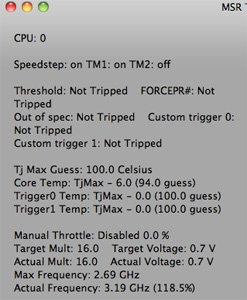The MacBook Pro Review (13 & 15-inch): 2011 Brings Sandy Bridge
by Anand Lal Shimpi, Brian Klug & Vivek Gowri on March 10, 2011 4:17 PM EST- Posted in
- Laptops
- Mac
- Apple
- Intel
- MacBook Pro
- Sandy Bridge
What About The 13?
Apple's new 13-inch MacBook Pro received the biggest upgrade of the lot. Last year Apple opted against moving the 13-inch model to Arrandale and instead gave it a beefy GPU and a mildly evolved Core 2 Duo CPU. The presumed public reasoning was Apple didn't like Arrandale's GPU performance and needed a two chip solution to maintain the platform's size hence the NVIDIA GT 330M + Intel Core 2 Duo setup. Internally I'm wondering if there was a small amount of corporate politics being played there. Apple used to get a discount on Intel CPUs in exchange for exclusivity, that agreement expired with Nehalem. When Nehalem hit, Apple had to pay the same price as everyone else for CPUs. Now does the 2010 Core 2 based 13-inch MacBook Pro make more sense? Keeping Intel's flagship CPU out of Apple's highest volume MacBook Pro had to hurt. I wonder if Apple got discounted pricing on Sandy Bridge as a result...
| Evolution of the 13-inch MacBook Pro | Early 2011 | Mid 2010 | Late 2009 |
| CPU | Intel Core i5 2.3GHz (DC) | Intel Core 2 Duo 2.40GHz (DC) | Intel Core 2 Duo 2.26GHz (DC) |
| Memory | 4GB DDR3-1333 | 4GB DDR3-1066 | 2GB DDR3-1066 |
| HDD | 320GB 5400RPM | 250GB 5400RPM | 160GB 5400RPM |
| Video | Intel HD 3000 (integrated) | NVIDIA GeForce 320M (integrated) | NVIDIA GeForce 9400M (integrated) |
| Optical Drive | 8X Slot Load DL DVD +/-R | 8X Slot Load DL DVD +/-R | 8X Slot Load DL DVD +/-R |
| Screen Resolution | 1280 x 800 | 1280 x 800 | 1280 x 800 |
| USB | 2 | 2 | 2 |
| SD Card Reader | Yes | Yes | Yes |
| FireWire 800 | 1 | 1 | 1 |
| ExpressCard/34 | No | No | No |
| Battery | 63.5Wh | 63.5Wh | 60Wh |
| Dimensions (W x D x H) | 12.78" x 8.94" x 0.95" | 12.78" x 8.94" x 0.95" | 12.78" x 8.94" x 0.95" |
| Weight | 4.5 lbs | 4.5 lbs | 4.5 lbs |
| Price | $1199 | $1199 | $1199 |
While the 15-inch MacBook Pro is quad-core only, the new 13 is strictly dual-core. You get two options: a 2.3GHz or 2.7GHz dual-core Core i5 or Core i7. In Intel speak it's the Core i5-2410M or the Core i7-2620M (it's no wonder Apple doesn't list model numbers for these things).

The 2011 13-inch MacBook Pro Motherboard
| Apple 13-inch 2011 MacBook Pro CPU Comparison | ||||
| 2.3GHz dual-core | 2.7GHz dual-core | |||
| Intel Model | Core i5-2410M | Core i7-2620M | ||
| Base Clock Speed | 2.3GHz | 2.7GHz | ||
| Max SC Turbo | 2.9GHz | 3.4GHz | ||
| Max DC Turbo | 2.6GHz | 3.2GHz | ||
| GPU Base Clock Speed | 650MHz | 650MHz | ||
| GPU Max Turbo | 1.2GHz | 1.3GHz | ||
| L3 Cache | 3MB | 4MB | ||
| AES-NI | No | Yes | ||
| VT-x | Yes | Yes | ||
| VT-d | No | Yes | ||
| TDP | 35W | 35W | ||
The primary differences between these two parts are clock speed, L3 cache size and AES-NI support once again. The 2.3GHz Core i5 lacks AES-NI, has a 3MB L3 cache and can only turbo up to 2.9GHz. The 2.7GHz Core i5 has AES-NI, a 4MB L3 cache and can turbo up as high as 3.4GHz.

I verified turbo frequencies on the 2.7GHz 13-inch. The highest I saw single core turbo hit was 3.4GHz, and dual core turbo was good for 3.2GHz. There's absolutely no funny business going on here, the dual-core 2.7 is allowed to hit its maximum frequencies.

You'll notice that the 2.7GHz DC chip has the same max single core turbo as the 2.3GHz QC chip from the upgraded 15-inch MacBook Pro. In practice this means that for light workloads the upgraded 15 won't feel any faster than the 13 (or that the 13 will feel as fast as the 15 depending on how you look at it). I'm talking about things like web page load times and application launch/install times. There may even be a slight performance advantage for the 13-inch setup as it's able to turbo up to higher frequencies easier than the quad-core 15. Crank up the threads and you've got a different story entirely of course. There's no replacement for more cores on highly threaded workloads.











198 Comments
View All Comments
tipoo - Thursday, March 10, 2011 - link
Its a shame that their base 15 inch, a 2000 dollar laptop, has a 256MB card by default. Even for non-gamers, that's starting to become a bottleneck. Especailly as this "pro" machine will make it into the hands of creative professionals, doing video work, rendering, mudbox, etc.Interesting about the performance differences in the HD3000 and 320M under Windows vs OSX.
tipoo - Thursday, March 10, 2011 - link
p.s whats an SNB GPU? Is that a typo? SB, perhaps?Brian Klug - Thursday, March 10, 2011 - link
When we say that, we're just referring to the Sandy Bridge (SNB) GPU. Essentially it's shorthand for the Intel HD Graphics 3000.-Brian
IntelUser2000 - Thursday, March 10, 2011 - link
The official short form for Sandy Bridge is SNB, not SB. SB is South Bridge.dcollins - Thursday, March 10, 2011 - link
For some reason Sandy Bridge is alway abbreviated as SNB. It took me a while to figure out.KoolAidMan1 - Thursday, March 10, 2011 - link
The baseline 15" MBP is $1800, not $2000.In any case, it is an unusual update. Usually the performance delta between MBPs hasn't been so extreme. The last generation had a common GPU between all 15" models, the main difference being video RAM. Now they have completely different GPUs, one being REALLY fast and the other not much better than the one that was in the models from last year.
saleem.kh - Sunday, March 13, 2011 - link
Dear, please consider approximately 9.5% US Sales Tax on $1,799. Then total price reaches to $2,000 approxPeteH - Monday, March 14, 2011 - link
There is no such thing as US Sales Tax, only state and local sales taxes. State rates range from a low of 0% to a high of 8.25% (I don't happen to know the range of local sales taxes). Adding 9.5% to the price of a computer seems completely arbitrary.turtle44 - Thursday, June 2, 2011 - link
sales tax in NY,NY is 11% don't say what you don't know.sfdiesel - Monday, July 25, 2011 - link
Sales tax in Portland, OR is 0%. So, adding 9.5% to the price of a computer does seem completely arbitrary.Do say what you don't know.